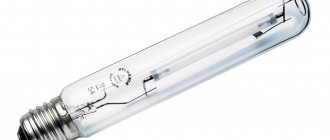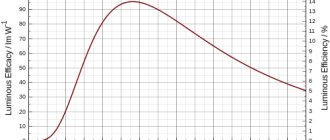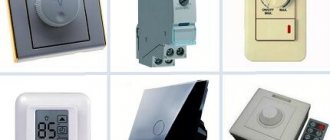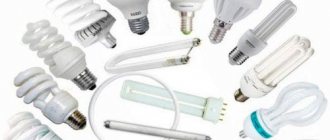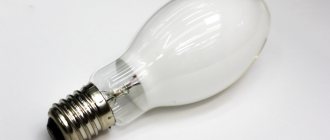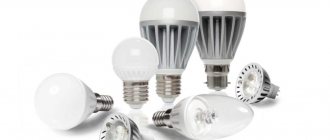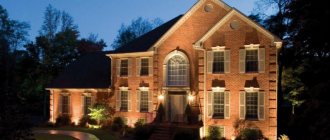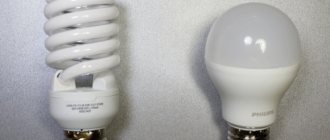: Use of undefined constant callback_thumbing_img — assumed \'callback_thumbing_img\' (this will throw an Error in a future version of PHP) in
/var/www/u0580466/data/www/svetilnik.info/wp-content/themes/sreda-design-nocat/includes/kama_thumbnail.php
on line
337
Choosing LED lamps is quite difficult for a non-specialist. The market offers a huge assortment, differing in LED type, size, design, and purpose. When developing a lighting system for a new house or apartment, it is advisable to involve a specialist. If you want to replace light bulbs in existing lamps, you can select and install them yourself if you have minimal knowledge about the features of LED light sources and manufacturers.
What is an LED module
An LED module (block, cluster) is a device or part of it, consisting of one or more LEDs and emitting light. In addition to the different number of diodes, the modules differ in size, voltage, current, brightness, color, and control method. The classic cluster contains mechanical, optical and heat-dissipating elements, but there is no control device.
The LED module may contain:
- only series-connected diodes;
- LEDs and current limiting elements;
- diodes, current limiters and a controller that controls the color and brightness of the light;
- LEDs, current limiters, controller and control unit that allows you to connect the cluster to the network.
Some modules are equipped with reflectors, lenses, and elements that protect from the sun. The sizes of such blocks are larger.
LED clusters are:
- independent (can be selected for installation outside the luminaire or housing);
- built-in (can be selected for installation in a housing or lighting fixture, replaced if it fails);
- one-piece (can be selected for installation in a housing or lighting fixture, cannot be replaced).
Regardless of the type, the module can be with or without a control device.
LED modules are also classified according to the place of use:
- in-house (SMD);
- external (DIP).
In the first, the diodes are soldered on the board, the brightness indicators are low, but the contrast level is high. DIPs are large, open, with two legs, bright, not contrasting, equipped with visors that protect from sunlight. Internal clusters are used to illuminate premises for various purposes, including residential ones. Clusters with DIP are used in landscape design and in the manufacture of advertising structures.
Reference! LED modules with a built-in control unit with a socket are LED lamps.
Power consumption analysis
It has already been mentioned that lighting power is a rather serious aspect, especially in conditions where every kilowatt of energy is taken into account. The thing is that LED lamps are very often used in industry. Accordingly, there may be several hundred, or even thousands, of such lighting devices. In such conditions, even before purchasing lamps, it is necessary to make detailed calculations to understand what the electricity consumption will be.
It is obvious that LEDs are significantly more economical than many other means of lighting that are used today. On a large scale, their use is the most acceptable option, allowing you to save tens of thousands of rubles.
At home, if you replace all incandescent lamps with LEDs, you can also experience significant savings. This is especially important if we take into account constantly rising electricity tariffs.
Finally, it is worth noting that it will not be possible to determine the degree of brightness or power of the light flux, even if the power consumption is known.
Experts advise paying attention to power consumption first of all, since it is this characteristic that determines what concerns ordinary consumers.
What to look for when choosing
The first thing you need to do before purchasing is to determine where the light source will be used - indoors or outdoors. The next parameter is the manufacturer. You should not immediately buy a module from an unknown manufacturer that is installed in a lighting fixture for a fluorescent or incandescent lamp. The best option is to choose a lighting fixture that is designed for LEDs and provides good heat dissipation.
It is important to choose the right power supply. This power factor should be 0.9, it is desirable to have a device that protects against voltage surges, interference and overheating. The seller must know the country of origin and provide a quality certificate.
Temperature of the light produced
Its “shade” depends on the temperature of the light:
- warm white (2700-3200K);
- day white (3500-4500K);
- white (5000-6000K)
- cold white (6000-8000K).
Important! An incandescent light bulb has a light temperature of 2700 K, a halogen bulb has a light temperature of 3000 K, and an LED bulb has a light temperature of 2200K - 10,000 K. When purchasing, the choice is made according to the kelvins indicated on the package, since the definitions of “daytime”, “cold”, “warm” vary from person to person. manufacturers differ.
The deviations regulated by standard C78.377A and the effect of each shade on humans should be taken into account. Warm white light relaxes, daylight improves performance, cold white light creates contrasts necessary when performing work that requires high precision.
SNiP 23-05-95 for residential premises recommends light with a temperature of 3000-4000K. If the interior color is blue or green, the temperature should be more than 4000 K. In a room with a lot of yellow and red color, the temperature should not exceed 3500 K.
Radiation angle indicator
The emission angle is the angle at which the light intensity decreases by 2 times. The light flux is emitted within these limits. The illumination area depends on the angle of radiation - the smaller the angle, the higher the illumination. In production and offices, the main part of the light beam should fall only on the work surface, without violating the requirements for uniformity of lighting.
Light direction
Unlike incandescent lamps and fluorescent light sources, LED lamps emit light only in one direction, and even in a small sector in front of them. This, of course, is a significant drawback, especially when it comes to using LEDs at home.
On the other hand, if we take into account the spread of heat from the lamp, then LEDs are much more attractive. Often heat escapes in the direction opposite to the light flow. Accordingly, this allows you to use this light source without any problems for a stretch ceiling, which under other conditions melts and becomes unusable.
To illuminate the entire room evenly, you will need several spotlights installed throughout the room.
Size guide markings
The dimensions of SMD LED housings can be determined by markings. For example, the length and width of SMD 5050 are 5 cm, the dimensions of SMD 3528 are 3.5x2.8 cm.
By marking DIP diodes, you can determine not only the dimensions. For example, for a round product, the marking 5RHWWC3000mcd6500K34V70 means that it is round (RH) with a diameter of 5 mm, the color is cold white (W), the body is transparent (WC), voltage 3.4 V, dispersion angle 70 degrees. The marking of the square DIP 8x8red50mcd2.1V indicates that the length and width are 8 mm, the color is red, the light intensity is 50 mcd, the voltage is 2.1 V.
On LED lamps with screw bases E 14 E 27, the numbers indicate the diameter of the bases. GU 5.3, GU 10 and G 13 are swivel sockets with a two-pin connector. The numbers indicate the distance between them.
Attention! When choosing light bulbs for luminaires with a pin base, sockets with appropriately sized spaces between the pins are required.
There are filament LED lamps with E 27 or E 14 sockets in which the driver is installed. Their sizes and shapes are different, most are similar to ordinary incandescent lamps, the numbers are the diameter of the base.
Glow degradation time
Manufacturers of LED modules and lamps indicate a long service life - from 20 thousand hours (for old models), up to 30-50 thousand hours for new SMDs, up to 100 thousand hours - for the most modern products. For the average consumer, it is important to know whether these numbers can be trusted.
Typically, service life is the period of time during which products stop working, not completely, but until the luminous flux parameters drop to a certain level. Some manufacturers take 30% as a threshold, others – 50%, but neither the technical documentation nor advertising materials indicate this, which prevents you from choosing a model.
Most often, the service life is 50 thousand hours (5 years and 8 months). It is impossible to verify this through testing. Models change very quickly, within 5 years others appear, and the old ones are no longer made. Tests are carried out quickly under extreme conditions.
The degradation time depends on:
- decreased diode performance;
- phosphor aging period;
- mechanical deformations;
- reduction in the characteristics of the primary optics.
The luminous flux is reduced mainly due to crystal degradation as a result of current leakage from the light-emitting areas. Degradation manifests itself as a decrease in voltage. In order for the service life to correspond to the declared one, the lighting device must operate in conditions in which the temperature does not increase. The current must correspond to the value specified by the manufacturer; it is advisable to install a device in the circuit that protects against static electricity. The crystal degrades very quickly if the solder joints are destroyed (there was a defect in production).
When a phosphor ages, it is not the brightness that changes, but the hue of the glow (a blue color appears). The primary optics are made from silicone and plastic. When exposed to ultraviolet light emitted by the LED, these materials become cloudy. The same thing happens when the temperature is too high. The service life is also reduced by a low-quality driver (if its power does not match the power of the diodes) and a decrease in the characteristics of the secondary optics (if any).
Attention! In the documents, manufacturers indicate the period that the LED is capable of operating under optimal conditions at the current and voltage specified in the technical documentation. Therefore, it is not necessary to increase the current to increase brightness.
Light transmission coefficient
In addition to the power parameter, any lamp used for lighting has a light transmission index characteristic, expressed in lumens. To determine it, you need to know its luminous flux. For example, if a light bulb shines with a power of 10 lm/W and has an energy consumption of 100 W, multiplying these values, we get 1000 lm - the light output level. This is a very important parameter that cannot be ignored when choosing an LED source. Otherwise, you can buy a low-quality product.
Interesting! Chinese underground diodes provide about 60-80 lm/W, while branded ones provide about 100-120, and very bright ones produced according to the COB standard provide at least 170-190 lm/W.
Common types of LED lamps
New lighting fixtures are purchased after the construction of a house is completed, when moving to a new apartment, or during renovations. Which one to choose depends primarily on the installation location and light level requirements.
Ceiling lamps are:
- for residential premises and offices;
- industrial, warehouse;
- street (landscape and for facades);
- for housing and communal services;
- for baths, saunas and swimming pools.
Indoor devices can be built-in or suspended, installed on walls, ceilings or interior items.
In any lighting device, not only the characteristics of the light sources are important, but also the design, type of installation, and purpose. Built-in models have high light output and can be chosen for various rooms.
Important! Dome luminaires are not suitable for residential premises, despite their good light transmission and high level of protection.
A ceiling lamp can be surface-mounted, recessed (in a pendant structure) or pendant (chandelier). Built-in models are produced with a housing equipped with a protective screen that prevents glare. LEDs are rarely chosen for chandeliers unless they have a lampshade or shade. The reason is the unattractive appearance due to the base in which the radiator is hidden.
Important! For a chandelier with a dense lampshade or frosted shades, you need to choose lamps with transparent bulbs, for crystal ones - with frosted bulbs. If you want to save money, you can buy light bulbs that support dimming.
LED lamps are often used in portable lamps and night lights. The former are suitable for focusing attention on individual areas or interior items, the latter - in places where it is necessary to turn the device in different directions.
AC and DC current source
The LEDs themselves, built into the lamps, operate on direct current with a voltage of 12V. At the same time, you need to know that circuits often contain special drivers that conduct voltage to the light source itself. Accordingly, in front of the driver there may be a connection to alternating current with a voltage of 220V to the most ordinary outlet. You can also find options with constant and alternating voltage from 12 to 24V.
Before buying a lamp, of course, it is worth clarifying the question about the current source. If the choice is made incorrectly, the LED may simply burn out, and the money spent cannot be returned.
If LED lamps have a driver, then the risk of the light source burning out is extremely low. Such lamps, most often, easily tolerate any voltage changes.
It is also interesting that when voltage changes, LED lamps practically do not change their brightness. This is another advantage compared to incandescent lamps, which under similar conditions can dim or flicker dynamically.
Main conclusions
The range of LED modules is huge, theoretically anyone can choose the one they need. For lamps used in residential premises, such indicators as the strength and aesthetic appeal of the body are important.
You should not choose light bulbs that do not have a brand name on them. The technical and operational characteristics of such products do not correspond to the declared ones - after a short time the color of the glow changes and the crystal begins to degrade.
If the seller is not ready to provide a quality certificate, it is better to look for another store.
Design characteristics
Type of climate control
This characteristic is indicated by letters that indicate the climate zone, and numbers indicating the category of placement of the lamp. For example, the UHL-1 marking means that the lamp can be used in temperate and cold climates outdoors in any weather.
Diffuser
LEDs create a point glow, for the dispersion of which special optical systems are used. Diffusers are made of polycarbonate, polypropylene, polystyrene, and heavy-duty glass. They can be in the form of a bulb, a flat panel, or a dome.
Frame
The body of the LED lamp is made of plastic or aluminum. In the second case, it also serves as a radiator, helping to remove heat from the LED chips.
Form
Manufacturers produce LED lamps in the form of:
- ball;
- round, rectangular and square panels;
- domes;
- ribbons and cords;
- household lamps with a bulb in the form of a pear, candle, mushroom, ball.
Mounting types
LED lamps are fixed to the mounting surface in different ways:
- embed;
- overhead mounting is used;
- suspended on cables;
- installed in tracking systems;
- fixed on brackets and consoles.

